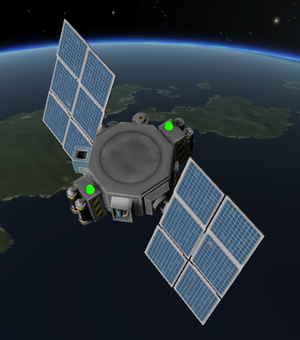Difference between revisions of "Electric charge/ja"
Kspjptrans (talk | contribs) (→エンジン内蔵発電機) |
Kspjptrans (talk | contribs) (→エンジン内蔵発電機) |
||
| Line 49: | Line 49: | ||
|} | |} | ||
| − | [[Rocket engine/ja|ロケットエンジン]]や[[jet engine/ja|ジェットエンジン]] | + | [[Rocket engine/ja|ロケットエンジン]]や[[jet engine/ja|ジェットエンジン]]の多くには発電機が内蔵されている。実際の発電量はスロットルの開放率に基づいて変化し、エンジンが停止していれば発電機能も働かない。右の表はエンジン別に真空中でスロットル全開にした場合の発電量を示している。Jet engines only generate electricity when supplied with [[intake air]]. |
=== 太陽光パネル === | === 太陽光パネル === | ||
Revision as of 01:24, 28 September 2014
Electric charge(電力 electricity、energyとも)は動力源の1つで様々なパーツを機能させるのに利用されている。無人機にとっては生命線で枯渇すると操作不能になる。有人機でもリアクションホイールなどの機能に不可欠である。
Contents
発電方法
エンジン内蔵発電機
| 分類 | パーツ名称 | 発電量 | Usage |
|---|---|---|---|
| ロケットエンジン | LV-T30 Liquid Fuel Engine | 7.0 e/s | 1.691 l/e |
| LV-T45 Liquid Fuel Engine | 6.0 e/s | 1.835 l/e | |
| Rockomax "Poodle" Liquid Engine | 8.0 e/s | 1.436 l/e | |
| Rockomax "Skipper" Liquid Engine | 10.0 e/s | 3.782 l/e | |
| Rockomax "Mainsail" Liquid Engine | 12.0 e/s | 7.715 l/e | |
| LV-N Atomic Rocket Motor | 5.0 e/s | 0.3055 l/e | |
| Toroidal Aerospike Rocket | 5.0 e/s | 1.828 l/e | |
| ジェットエンジン | Basic Jet Engine | 4.0 e/s | ? |
| TurboJet Engine | 5.0 e/s | ? |
ロケットエンジンやジェットエンジンの多くには発電機が内蔵されている。実際の発電量はスロットルの開放率に基づいて変化し、エンジンが停止していれば発電機能も働かない。右の表はエンジン別に真空中でスロットル全開にした場合の発電量を示している。Jet engines only generate electricity when supplied with intake air.
太陽光パネル
Solar panels are a lightweight source of electrical energy. However, they need direct sunlight to work, so they won't produce electricity on the night side of a planet, in the shadow of a spacecraft or during eclipses of the sun, although the craft is illuminated while in an eclipse. Due to this unreliability, it is recommended to have some energy storage as a buffer when supplying a craft solely with solar panels.
All panels except for the OX-STAT Photovoltaic Panels need to be extended using the right-click menu or action groups before they will generate energy. Unpacked solar panels are very fragile and will easily break off when colliding or experiencing atmospheric drag, so they must be retracted during liftoff, aerobraking, or atmospheric re-entry.
The energy output of solar panels depends on their orientation to Kerbol. Except for the surface-mounted OX-STAT Photovoltaic Panels, all panels will automatically pivot around one axis to face the sun as much as possible. Reorienting a vessel to manually aim the panels at the sun and eliminate shadows cast on them will also improve power generation.
Generated power will also decrease with increasing distance from Kerbol, but rather than following the real-life inverse-square law it experiences a spline curve of 3 piecewise cubics defined from 4 points:
| Distance (m) | Power | Comment |
|---|---|---|
| 0 | 10x | |
| 13,599,840,256 | 1x | Kerbin's orbit |
| 68,773,560,320 | 0.5x | Jool's semi-major axis |
| 206,000,000,000 | 0x | Almost 3x Jool's orbit |
原子力電池
PB-NUK Radioisotope Thermoelectric Generatorは太陽光を必要とせず、常に一定量の発電ができ、耐久性も高く空気抵抗にも強い、信頼性の高い電力源である。ただし同程度の発電力を持つ太陽光パネルと比べて大幅に重量が多い。
打ち上げ支柱
TT18-A Launch Stability Enhancerには1基あたり1.0 E/sの充電機能があるため打ち上げ前は電源枯渇を防ぐことが出来る。
Storage
Storing electric charge helps a craft survive longer without energy supply, deal with peak loads (like transmitting science results) or bridge time gaps when solar panels aren't usable. The following parts store energy:
- Unmanned command modules offer very low capacities and constantly consume energy.
- Manned command modules offer significant storage capacities and do not consume energy (unless when reaction wheels or SAS are used) but are relatively large and heavy.
- Batteries are small and offer high storage capacities at the same time. All have the same capacity/mass ratio of 50 g/E or 20 E/kg.
- The Probodobodyne RoveMate functions like a large low-capacity battery.
All energy storage available to a craft is fully loaded at launch.
Consumption and requisition
- Unmanned command modules constantly use 1.7 or 3.0 units of electric charge per minute and can only store enough internally for a few minutes of operation.
- Reaction wheels, both the stand-alone parts and as part of command capsules, consume energy while operating.
- In career mode, antennae require large amounts of energy for a short time when they transmit science to the space center.
- Electric lights and environmental sensors use small quantities of electricity when switched on.
- Ion engines, and rover wheels require particularly large amounts of electricity to operate.
If an unmanned craft has no electric charge available, it becomes entirely nonfunctional and no parts may be operated (notably, this includes motorized solar panels which might have allowed it to recover). However, it can still be saved if another craft docks to it and supplies it with electricity, or if a kerbonaut on EVA manually extends the solar panels.
